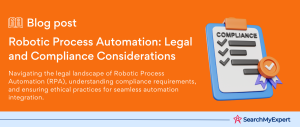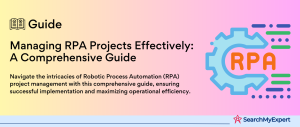Understanding Robotic Process Automation (RPA) in Healthcare
Robotic Process Automation, commonly known as RPA, is revolutionizing various industries, and healthcare is no exception. At its core, RPA involves the use of software robots, or “bots,” that can mimic human actions to complete repetitive, rule-based tasks. This technology is particularly valuable in healthcare, a sector inundated with data-driven processes and administrative tasks.
The Potential Benefits of RPA in Healthcare
The application of RPA in healthcare brings a myriad of benefits. These include:
- Increased Efficiency and Productivity: RPA bots can operate 24/7 without breaks, significantly reducing the time required to perform routine tasks like data entry, appointment scheduling, and patient record management.
- Enhanced Accuracy: By automating tasks, RPA reduces the risk of human error, ensuring more accurate patient records and billing information.
- Cost Reduction: Automating routine processes reduces the need for manual labor, leading to significant cost savings for healthcare organizations.
- Improved Patient Care: By handling administrative tasks, RPA allows healthcare professionals to focus more on patient care and less on paperwork.
- Scalability:
RPA can be scaled up or down based on the needs of the healthcare provider, offering flexibility in resource management.
Global Adoption of RPA in Healthcare
The adoption of RPA in healthcare is on a significant rise globally. This trend is driven by the need for efficiency and accuracy in healthcare operations, alongside the growing amount of healthcare data. RPA technologies are being employed in various aspects of healthcare, including patient appointment scheduling, claims processing, patient data management, and compliance monitoring. This global shift towards automation is not just a technological leap but also a strategic move to improve healthcare delivery and patient outcomes.
Exploring the Diverse Applications of RPA in Healthcare Workflows
Robotic Process Automation (RPA) is making a significant impact across various facets of healthcare, streamlining operations and enhancing patient care. Here’s a closer look at how RPA is transforming different healthcare workflows:
RPA in Administrative Tasks
- Patient Registration: RPA bots are capable of automating the entire patient registration process, from data entry to document verification. This minimizes wait times and enhances the patient admission experience.
- Data Entry and Management:
RPA streamlines data entry tasks, ensuring accurate and up-to-date patient records. It can automatically update patient histories, treatment plans, and billing information. - Claims Processing:
RPA simplifies the complex and time-consuming process of insurance claims processing. It handles tasks such as claims verification, processing, and communication with insurance providers, reducing the scope for errors and delays.
RPA in Clinical Tasks
- Medication Management:
RPA helps in managing medication orders and inventories, ensuring timely updates and accuracy. It also assists in tracking patient medication schedules, reducing the risk of medication errors. - Appointment Scheduling:
RPA bots can efficiently manage appointment scheduling and rescheduling, providing reminders to patients and optimizing healthcare professionals’ schedules. - Clinical Reporting:
RPA aids in the generation and distribution of clinical reports, such as lab results and diagnostic reports, enhancing the speed and accuracy of information flow.
RPA in Operational Tasks
- Inventory Management: RPA plays a crucial role in inventory control, tracking stock levels, and automating orders for medical supplies. This ensures that necessary supplies are always available without overstocking.
- Supply Chain Management:
In the supply chain, RPA optimizes processes like order processing, tracking shipments, and managing vendor relationships, ensuring a smooth flow of medical goods. - Financial Reporting:
RPA enhances financial operations by automating the preparation and consolidation of financial reports, budgeting, and forecasting. This leads to more efficient financial management and compliance.
Maximizing Healthcare Delivery: The Advantages of Implementing RPA
The implementation of Robotic Process Automation (RPA) in healthcare brings a host of advantages that are transforming the sector. Let’s delve into these benefits:
Increased Efficiency and Productivity
- Streamlined Operations:
RPA bots handle repetitive tasks quickly and tirelessly, significantly speeding up processes like appointment scheduling, data entry, and record-keeping. - 24/7 Functionality:
Unlike human workers, RPA systems can operate around the clock, ensuring continuous productivity. - Reduced Workload for Staff: By taking over routine tasks, RPA allows healthcare staff to focus on more complex and patient-centric activities.
Improved Accuracy and Reduced Errors
- Precision in Data Handling: RPA minimizes human error in data entry and management, ensuring high accuracy in patient records, billing, and reporting.
- Consistency in Processes:
Automation ensures that tasks are performed in a uniform manner, reducing variability and enhancing reliability in healthcare services.
Cost Reduction and Resource Optimization
- Reduced Operational Costs:
Automation cuts down the time and resources spent on administrative tasks, translating to lower operational costs. - Optimal Resource Allocation:
RPA allows healthcare facilities to allocate human resources to more critical areas, enhancing overall efficiency and effectiveness.
Enhanced Patient Experience and Satisfaction
- Faster Service Delivery:
Automated processes lead to quicker response times for patient needs, from registration to treatment. - Personalized Patient Interaction:
With RPA handling administrative tasks, healthcare professionals can devote more time to patient care, offering a more personalized and engaging experience. - Reduced Waiting Times: Streamlined scheduling and data processing mean shorter waiting times for patients, improving overall satisfaction.
Increased Compliance with Regulations
- Adherence to Standards:
RPA can be programmed to comply with healthcare regulations and standards, ensuring adherence to legal and ethical guidelines. - Accurate Reporting for Compliance:
Automation aids in precise and timely reporting, vital for maintaining regulatory compliance in healthcare.
Navigating the Challenges and Considerations for Successful RPA Implementation in Healthcare
Implementing Robotic Process Automation (RPA) in healthcare, while beneficial, comes with its own set of challenges and considerations. Addressing these effectively is crucial for a successful and sustainable RPA strategy.
Integration with Existing Systems and Data Security
- System Compatibility:
Integrating RPA with existing healthcare IT systems can be complex. It requires careful planning to ensure compatibility and seamless functionality. - Data Security Concerns: Healthcare data is sensitive and highly confidential. Implementing RPA necessitates robust security measures to protect patient data from breaches and unauthorized access.
Change Management and Workforce Training
- Overcoming Resistance to Change:
The introduction of automation may be met with resistance from staff. Effective change management strategies are needed to address concerns and promote acceptance. - Training and Skill Development:
Employees need to be trained to work alongside RPA tools. This includes understanding how to manage and interact with these systems effectively.
Regulatory Compliance and Potential Ethical Concerns
- Maintaining Compliance: The healthcare sector is heavily regulated. RPA solutions must be compliant with healthcare standards and regulations, such as HIPAA in the United States.
- Ethical Implications:
There are ethical considerations, such as the impact of automation on employment and patient privacy. It’s essential to address these concerns transparently and responsibly.
Measuring Success and Demonstrating ROI
- Setting Clear Metrics for Success:
Establishing key performance indicators (KPIs) is critical to measure the effectiveness of RPA implementation. - Demonstrating Return on Investment (ROI):
Healthcare organizations need to track and report the financial and operational benefits of RPA to justify the investment and plan for future expansions.
Envisioning the Future of RPA in Healthcare: Trends and Advancements
The future of Robotic Process Automation (RPA) in healthcare is poised for groundbreaking advancements and integration with cutting-edge technologies. Let’s explore the upcoming trends and potential impacts of these developments on healthcare delivery.
Upcoming Trends and Advancements in Healthcare RPA
- Advanced Data Analytics:
RPA systems are expected to integrate more deeply with data analytics, enabling real-time data processing and decision-making in healthcare operations. - Predictive Healthcare Management:
Future RPA tools may be capable of predicting patient care requirements, staffing needs, and inventory requirements, leading to more proactive healthcare management. - Enhanced Patient Interaction Bots: We will likely see more sophisticated bots that can interact with patients for appointment scheduling, reminders, and even initial symptom assessment.
Integration of RPA with AI and Other Technologies
- Combining RPA with AI:
The integration of Artificial Intelligence (AI) with RPA is set to create intelligent automation solutions. These AI-enabled bots can learn from data patterns and make informed decisions, enhancing the scope and efficiency of healthcare services. - Interoperability with IoT Devices:
RPA might be integrated with Internet of Things (IoT) devices in patient care, such as wearable health monitors, for seamless data collection and analysis. - Blockchain for Enhanced Security: Incorporating blockchain technology can improve data security in RPA systems, ensuring tamper-proof record-keeping and enhanced patient data privacy.
Predicting the Impact of RPA on Healthcare Delivery
- Personalized Patient Care:
With RPA’s ability to - Efficiently handle routine tasks, healthcare providers can focus more on personalized patient care, tailoring treatments and interactions based on individual patient needs and histories.
- Reduced Healthcare Costs:
The operational efficiency brought about by RPA has the potential to significantly reduce healthcare costs, both for providers and patients, by streamlining processes and reducing the need for manual labor. - Improved Healthcare Access: The efficiency and scalability of RPA could lead to broader access to healthcare services, especially in remote or underserved areas. Automated systems can facilitate telehealth services and remote patient monitoring, making healthcare more accessible.
- Enhanced Research and Development: RPA’s ability to efficiently process and analyze large volumes of data can accelerate research and development in healthcare. This could lead to faster drug discovery, improved treatment methods, and a better understanding of diseases.
- Impact on Healthcare Workforce:
While RPA will automate many tasks, it will also create new roles focused on managing and optimizing these automated processes. The healthcare workforce will need to adapt, gaining skills in technology management and analysis.
Showcasing Real-World Success Stories of RPA in Healthcare
Robotic Process Automation (RPA) in healthcare has led to several notable success stories, illustrating the transformative impact of this technology. Below are real-world examples showcasing the efficiency and effectiveness of RPA implementations.
Post-Discharge Care Enhancement
- Case Study:
RPA technology has enabled holistic post-discharge care, significantly improving the at-home recovery process for patients. By sending automated reminders for medication, follow-ups, and critical data measurements like blood sugar levels and blood pressure, RPA enhances patient experience and safety. - Quantified Outcomes:
This approach has been crucial in supporting patients confidently and effectively during their recovery at home.
Asset Tracking and Management
- Case Study:
In healthcare facilities, RPA has been instrumental in tracking essential assets like ventilators and medical pumps. By integrating RPA with cloud-based control panels and digital sensors, healthcare professionals can locate equipment in real time, saving considerable time and reducing procurement costs. - Quantified Outcomes:
This implementation has dramatically decreased the time nurses spend searching for equipment, which was previously around 6,000 hours a month, thus enhancing patient care efficiency.
Improved Patient Registration and Onboarding
- Case Study: New Bedford Corporation, a medical billing and coding provider, implemented an RPA solution from Nintex for patient registration and onboarding. This resulted in a more efficient management of patient data.
- Quantified Outcomes: The company improved patient records and billing entry time by 62% and saved approximately $70,000 in labor costs.
Enhanced Billing and Claims Processing
- Case Study: Baptist Health South Florida used Fortran Automate for claims processing, which automated various tasks, including claims management and first-line inquiries.
- Quantified Outcomes:
This automation reduced manual workloads by around 10 hours a week, significantly improving processing efficiency and customer service.
Comprehensive Revenue Cycle Management
- Case Study:
A medical billing company utilized RPA for revenue cycle management processes, automating tasks like patient registration, billing, and claims processing. - Quantified Outcomes:
The implementation of RPA led to an estimated 70% reduction in resource costs for the hospitals served by this company.
Testimonials from Healthcare Professionals and Patients
Healthcare professionals have lauded RPA for its ability to free up time from administrative tasks, enabling them to focus more on patient care. They’ve noted improvements in data accuracy, operational efficiency, and patient safety. Patients, on the other hand, have appreciated the reduced wait times, smoother onboarding processes, and more personalized care resulting from RPA implementation.
Revolutionizing Healthcare: The Transformative Potential of RPA
Key Points of RPA in Healthcare
- Definition and Context:
Robotic Process Automation (RPA) in healthcare refers to the use of bots to automate repetitive, rule-based tasks, leading to increased efficiency and accuracy in healthcare operations. - Applications Across Workflows:
RPA has diverse applications in administrative, clinical, and operational tasks, streamlining processes like patient registration, appointment scheduling, and inventory management. - Advantages for Healthcare Delivery: The implementation of RPA results in increased efficiency and productivity, improved accuracy, cost reduction, enhanced patient experiences, and compliance with regulatory standards.
- Challenges and Considerations:
Successful RPA implementation requires careful integration with existing systems, workforce training, adherence to regulatory compliance, and effective measurement of ROI. - Future Prospects:
The future of RPA in healthcare is marked by advancements in AI integration and predictive analytics, set to further revolutionize healthcare delivery.
The Transformative Potential of RPA
Robotic Process Automation holds immense potential to revolutionize the healthcare industry. By automating mundane and repetitive tasks, RPA allows healthcare professionals to concentrate more on patient care, leading to improved outcomes and experiences. This technology not only enhances operational efficiency but also plays a pivotal role in reducing errors, ensuring data accuracy, and optimizing resource allocation.
Encouraging Further Exploration and Adoption
The journey of integrating RPA in healthcare is still in its early stages, with vast potential for growth and optimization. Healthcare organizations are encouraged to explore and adopt RPA technologies, recognizing the significant benefits they offer. As healthcare continues to evolve with technological advancements, RPA stands out as a key player in shaping a more efficient, accurate, and patient-centric future.
Conclusion:
Robotic Process Automation stands as a beacon of innovation in healthcare, offering a multitude of benefits from operational efficiency to improved patient experiences. As we look towards the future, the integration of RPA with advanced technologies like AI promises to further elevate the standards of healthcare delivery. The journey of RPA in healthcare is an evolving narrative of technological advancement, offering a glimpse into a future where healthcare is more accessible, accurate, and patient-focused than ever before. For healthcare organizations worldwide, the exploration and adoption of RPA represent a forward leap into a new era of medical excellence and patient care.
Redefine efficiency with our Robotic Process Automation Services.
Further Reading
Table of Contents
Toggle






